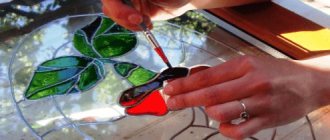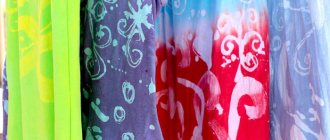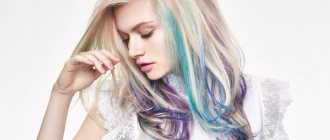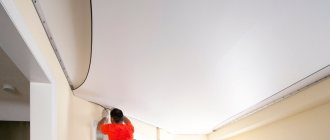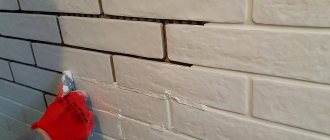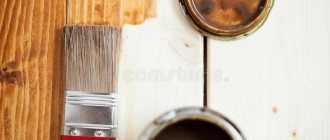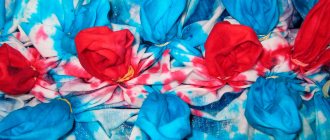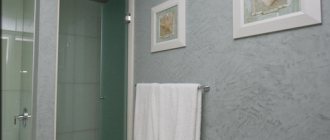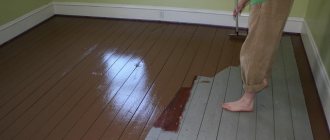Types of fabric paints
The most popular type of fabric paint is acrylic. These dyes do not penetrate into the fiber, but form a film on it. The painted area becomes dense and inelastic. Acrylic dyes are waterproof and have bright colors.
Aniline dyes penetrate into the fibers of the fabric, so the color lasts for a long time. Stamp inks are very durable and do not fade even after washing with bleach. They are used more for marking clothes than for dyeing.
Paints are produced in different forms:
- liquid in tubes or jars;
- spray in a can;
- powder.
You can purchase the dye at a hardware store or craft department. There is a whole network of hypermarkets for creativity “Leonardo”, where a large assortment of dyes is presented.
Hair dyes are not suitable for dyeing fabrics. They lie on the material unevenly, things turn out spotty. In addition, these dyes quickly fade and fade when washed.
It is also better to avoid painting fabric with green paint. The antiseptic gives a bright emerald color, but is easily washed off with water. When washed, it will fade and stain other things.
Chemical dyes
Acrylic dyes are based on polymers. Their advantages:
- There is always a wide range on sale;
- safe;
- the paint can be diluted with water;
- variety and brightness of colors;
- shades can be mixed to create new options;
- waterproof.
The disadvantages include the strong fluidity of the paint. Therefore, you need to make an additional outline on the fabric. During long-term storage, the dye thickens and loses its coloring properties.
Acrylic dyes can be used to dye any type of fabric:
- denim;
- silk;
- cotton;
- linen
The exception is wool, on which the dye will crack. On jars and tubes of paint there are marks:
- silk - for cambric, silk, chiffon;
- textile - leather, velvet, suede.
Acrylic fits well on dense material - the design gets clear boundaries and bright color.
Aniline dyes are also waterproof and come in liquid and powder. Suitable for dyeing natural fabrics - cotton, wool, linen. The pigment is water-soluble and liquid, making it inconvenient to paint with. Aniline dyes are suitable for changing the color of an entire item at once.
Stamp inks are:
- alcohol;
- water-glycerin;
- oil
They are applied to any type of fabric and are produced mainly in black or blue.
Natural dyes
Made from brightly colored plants. Less persistent than chemical dyes, but safe for allergy sufferers and people with chronic skin diseases.
Colors of natural dyes:
- yellow - turmeric root, orange zest;
- indigo - a mixture of spinach and turmeric;
- brown - onion peels, oak bark, tea leaves;
- gray - bearberry, broom;
- red or purple - beets;
- purple - blueberries;
- blue - sage.
They dye things by boiling them in a solution of natural dye. To fix the color, you need to hold the item in an alum solution for 20 minutes.
See how to paint with natural paints:
Aerosols
Aerosol paints are available in cans. They are convenient for painting large things - scarves, bedspreads. The pigment applies smoothly, without smears. The cans have different hole diameters, so you can paint large and small details of the design.
Glowing colors
Glowing dyes contain fine luminescent powder - phosphor. It glows in the dark. Does not contain phosphorus, therefore safe for humans. Fluorescent paints are made on the basis of plastisol. They glow in the dark or under UV light.
The reflective effect is achieved due to phosphor. Such pigments are used for application to children's clothing so that the child is clearly visible to motorists on a dark street.
Acrylic dyes
They are better suited than others for painting cotton, wool and silk fabrics. They are convenient for creating both bitmaps and real masterpieces. Original colorful clothes will highlight your individuality.
The technique of painting with indelible acrylic paint is similar to working with gouache or watercolor. First you need to apply contours to the material with a pencil or a specially designed marker, then use a natural brush.
Acrylic dyes that have a water-dispersion base are used for painting fabrics. They lend themselves well to dilution with water, have no odor, and when completely dry, they become indelible. However, in order to avoid stains, such clothes should be gently washed by hand with water heated to no more than 40 degrees.
Acrylic paints are available for sale in cans, tubes and spray form.
The highest quality acrylic dyes are produced by manufacturers:
- Decola;
- Dylon;
- Simplicol;
- Marabu.
Popular paint manufacturers
Manufacturers of acrylic paints:
- "Decola";
- "Delon";
- "Simplicol";
- "Marabou";
- "Pebeo";
- "Javana";
- "Gamma";
- "Pigment Acrylic";
- "Surf";
- "Ideal".
Lumier has gold and silver dyes that give a metallic effect.
St. Petersburg Decola paints are the most popular among batik artists. Sold individually and in sets. Additionally there are brushes, solvents, contours. The average cost is 110 rubles per 50 ml jar.
- French manufacturer. Their textile dyes are easy to use and safe. An additional assortment is represented by brushes, solvents, and stencils. The average cost is 300 rubles per 45 ml jar.
German offers a wide range of products. They have a lot of pigments of different colors, brushes, applicators, stencils. Pigments are convenient for drawing small details. To fix the color, just iron the item with an iron. The average cost is 70 rubles per 20 ml jar.
The pigments are suitable for coloring natural and synthetic materials. They are easy to use, even when painting by hand. Gives a rich color. The average cost is 70 rubles per 20 ml jar.
Screen printing inks are water-based. Light colored material should be dyed. The average cost is 130 rubles per 50 ml jar.
Preparatory work
The preparatory stage involves soaking the clothing (the base to be dyed) in cold water for an hour. After soaking, the base is hand washed and rinsed. Dyeing is done on dry fabric, so the clothes must be thoroughly dried. The dried fabric is ironed with an iron set to medium temperature. If the clothes are made of thin fabric, you can stretch them on a wooden frame to dry. When hand painting, you need to place a slightly absorbent base (for example, cardboard, thick paper) or a non-absorbent base (a piece of film) under the fabric to be painted.
Soaking clothes in cold water
Dyeing fabric at home
Before you dye the fabric, you need to prepare it. The item, especially if it is new, should be washed. Many fabrics shrink after washing, so if you wash an item after dyeing, the design will become deformed.
For dark fabrics, you should use a primer - paint adheres better to it. The primer you need is not an ordinary acrylic one, it is too dense. White or pearlescent paints are suitable.
To work you will need the following tools:
- pencil or special solution for drawing an outline;
- tassels;
- cellophane film;
- hoops or frames for stretching fabric;
- a jar of water;
- stencils;
- cotton buds.
Useful tips for painting on fabric:
- you need to start painting with light acrylic paints, and then add dark tones;
- make color transitions quickly, because acrylic dries quickly;
- after applying the first layer, the item should be set aside to dry for a day;
- after painting is completed, dry the item for another day, and then iron it through the fabric;
- when dyeing, place cellophane under thin fabric so that the paint does not leak;
- To draw on the material, use a special marker, traces of which disappear after washing;
- During painting, brushes should be washed with clean water more often so that the colors do not mix.
After use, clean the brushes with a degreaser - nail polish remover, acetone.
See what mistakes you should not make when painting on fabric:
How to take better care
The quality of painting at home differs from that in a factory, so more careful care of clothes is required.
Tips on how to keep your coloring longer
- The first few washes should be carried out separately, as the paint may come off intensively;
- Use washing powder for colored items;
- Wardrobe parts painted with acrylic paints should be washed by hand at a temperature not exceeding 40⁰C;
- Rinse after washing to fix the color separately by adding vinegar to the water;
- Dry in the shade (the product will fade when exposed to sunlight).
Modern ideas for dyeing clothes allow you to create new creative images of your favorite things at home. A little imagination, desire and creative experimentation will delight you with its interesting results.
Material dyeing technology
You can paint things in different ways. Technologies for coloring the entire thing:
- manual - boil the item in a pigment solution;
- wash with pigment in the washing machine.
You don’t have to paint the entire material, but just apply a design to it. This technology is called batik.
In the washing machine
You can dye an item by washing it in a washing machine with dye. The method is simple and fast, but has a drawback - paint particles settle on the inner surface of the drum. Items may be damaged during subsequent washing.
After dyeing in the washing machine, you need to rinse it - run the washing cycle twice without clothes or with unnecessary fabric.
Algorithm for dyeing in a washing machine:
- dilute the paint and pour it into a container for powder;
- wet the item, put it in the drum;
- run the wash with water heated to 90 degrees for 30 minutes;
- turn off spin.
After washing, rinse the item with cold water.
To watch the video of coloring the product:
Aniline dyes
This type of permanent paint comes in liquid or powder form. Used for uniform dyeing of fabrics made from natural fibers.
Synthetics usually change color poorly, as well as mixed materials containing more than 60 percent artificial fibers.
The procedure for working with aniline dyes is as follows:
- The color is diluted with a large volume of water in a ratio of 1/30 or 1/40 to the weight of the material. For example, for a towel weighing 100 grams, you can use 3 or 4 liters of dye solution.
- The fabric is completely immersed in liquid and boiled at 95 degrees. If you boil longer, the color will become brighter.
- To fix the color at the last moment, add 2-5 tablespoons of table salt.
- When dyeing a wool product, you must additionally add two tablespoons of vinegar to the water. For cotton - baking soda.
- After finishing the painting process, the product should be rinsed in cool water. During the first three washes, the item will most likely fade, so it is better to wash it separately.
The method described is batik dyeing. You can achieve a different result by working with aniline dyes:
- Gradient . The material is gradually lowered into a container with a dye at regular intervals. Then the part of the fabric immersed in paint for a longer time will be a couple of tones darker than the part that was immersed much later.
- Divorces . The material is twisted by hand, as if squeezing, and tied tightly with a cord. In this form, the fabric is boiled in a dye solution.
- Knot pattern . Coins or buttons are wrapped in cloth, threaded, and the material is boiled in dye. The result is a characteristic ray-shaped pattern.
Cons and limitations
Acrylic paints cannot be called a one hundred percent widely used finishing material. Despite the fact that they are popular in various fields of activity and handicrafts, there are limitations to their use.
Types of things you should not paint on with acrylics:
- Bed sheets. Repeated washing will quickly fade and erase the design.
- Personal underwear. There is a possibility of an allergic reaction.
- Children's things (for children of kindergarten age). There is the same danger of allergies.
- Any textile, knitted or woven products that are dry cleaned. The drawing will simply be ruined.
Over time, the acrylic coating deteriorates (wears off, cracks). Without contours, paint often bleeds. Sometimes it is difficult to achieve the desired shade when mixing paints.
Factory-made bed linen with patterns made from acrylic paints is made using special technology Source selcdn.fedsp.com
Factory-made children's clothes are decorated with acrylic paints using special technology Source livemaster.ru

